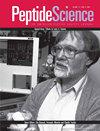通过人类 ACE2 拟态设计阻断病毒感染的碳氢叠肽中结构灵活性的作用
IF 1.7
4区 生物学
Q4 BIOCHEMISTRY & MOLECULAR BIOLOGY
引用次数: 0
摘要
COVID-19 大流行推动了人们对多肽、抗体、蛋白质和小分子抗病毒药物潜力的热切探索,以对抗严重急性呼吸系统综合征-冠状病毒 2(SARS-CoV-2)。SARS-CoV2 尖峰蛋白与血管紧张素转换酶 2(ACE2)受体之间的相互作用是一个特别有趣的目标,因为它介导了病毒细胞的进入。这种 PPI 是由 ACE2 的 α-helical 部分与尖峰蛋白的受体结合域 (RBD) 结合所介导的,并被认为容易通过分子模拟而被阻断。对少量旨在破坏或阻断这种相互作用的碳氢化合物标记合成肽进行了单独测试,结果发现,尽管这些肽具有相关或重叠的序列,而且α-螺旋度也同样增加,但它们的功效却各不相同。造成这些差异的原因尚不清楚,临床前成功的报道也很有限。本研究试图通过评估一系列碳氢化合物钉合肽来更好地了解这些差异的原因,这些肽的设计基于四个不同的原则:钉合位置、钉合数量、氨基酸序列和主序列长度。令人惊讶的是,我们观察到碳氢化合物钉合肽的螺旋度和氨基酸序列迭代与其生物活性并不相关。我们的研究结果凸显了对这些化合物进行迭代和组合测试的重要性,以确定最能模拟天然结合的构型,并在牺牲结构螺旋度的同时允许链的灵活性。本文章由计算机程序翻译,如有差异,请以英文原文为准。
The Role of Structural Flexibility in Hydrocarbon‐Stapled Peptides Designed to Block Viral Infection via Human ACE2 Mimicry
The COVID‐19 pandemic drove a uniquely fervent pursuit to explore the potential of peptide, antibody, protein, and small‐molecule‐based antiviral agents against severe acute respiratory syndrome‐coronavirus 2 (SARS‐CoV‐2). The interaction between the SARS‐CoV2 spike protein with the angiotensin‐converting enzyme 2 (ACE2) receptor that mediates viral cell entry was a particularly interesting target given its well‐described protein–protein interaction (PPI). This PPI is mediated by an α‐helical portion of ACE2 binding to the receptor binding domain (RBD) of the spike protein and thought to be susceptible to blockade through molecular mimicry. Small numbers of hydrocarbon‐stapled synthetic peptides designed to disrupt or block this interaction were tested individually and were found to have variable efficacy despite having related or overlapping sequences and similarly increased α‐helicity. Reasons for these differences are unclear and reported preclinical successes have been limited. This study sought to better understand reasons for these differences through evaluation of a comprehensive collection of hydrocarbon‐stapled peptides, designed based on four distinct principles: stapling position, number of staples, amino acid sequence, and primary sequence length. Surprisingly, we observed that the helicity and amino acid sequence iterations of hydrocarbon‐stapled peptides did not correlate with their bioactivity. Our results highlight the importance of iterative and combinatorial testing of these compounds to determine a configuration that best mimics natural binding and allows for chain flexibility while sacrificing structural helicity.
求助全文
通过发布文献求助,成功后即可免费获取论文全文。
去求助
来源期刊

Peptide Science
Biochemistry, Genetics and Molecular Biology-Biophysics
CiteScore
5.20
自引率
4.20%
发文量
36
期刊介绍:
The aim of Peptide Science is to publish significant original research papers and up-to-date reviews covering the entire field of peptide research. Peptide Science provides a forum for papers exploring all aspects of peptide synthesis, materials, structure and bioactivity, including the use of peptides in exploring protein functions and protein-protein interactions. By incorporating both experimental and theoretical studies across the whole spectrum of peptide science, the journal serves the interdisciplinary biochemical, biomaterials, biophysical and biomedical research communities.
Peptide Science is the official journal of the American Peptide Society.
 求助内容:
求助内容: 应助结果提醒方式:
应助结果提醒方式:


